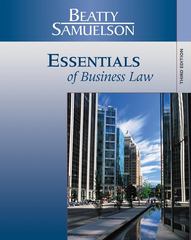Question
Question 16 The US Department of Commerce likely raised tariffs on Chinese solar-product manufacturers in an effort to: a) completely halt the import of Chinese
Question 16
The US Department of Commerce likely raised tariffs on Chinese solar-product manufacturers in an effort to:
a)
completely halt the import of Chinese solar-products into the United States.
b)
help US consumers of solar products.
c)
put a limit on the number of Chinese solar products imported by US consumers.
d)
give US solar-product manufacturers an opportunity to gain market share.
e)
make it cheaper for US consumers to buy solar products from China.
Question 17
Someone in support of trade restrictions would argue that:
a)
trade restrictions reduce the number of domestic jobs.
b)
trade restrictions can protect new or weak industries.
c)
trade restrictions enhance consumer choices.
d)
trade restrictions can damage national security.
e)
trade restrictions damage the health of citizens in your country.
Question 18
The primary objective of the World Trade Organization is to:
Question 18 options:
a)
reduce barriers to trade worldwide.
b)
provide low-interest loans.
c)
promote the invention of new technologies.
d)
help developing countries build a viable economy.
e)
provide technical assistance to developing countries.
Question 19
Who are the members of NAFTA?
a)
The United States, Canada, and the United Kingdom
b)
Greenland, Iceland, and Canada
c)
Guatemala, Honduras, and Mexico
d)
The United States, Canada, and Mexico
e)
The United States, Mexico, and Japan
Question 20
The simplest form of business owned and operated by one person is called a(n):
a)
syndicate.
b)
franchise.
c)
S-corporation.
d)
sole proprietorship.
e)
partnership.
Question 21
Marquez is interested in starting his own business. He has sufficient funds to start up the business but if it becomes as successful as he believes it will, he'll need to secure significant additional funding. Which question should Marquez ask himself?
a)
How will day-to-day management decisions be made?
b)
Will the business have additional owners or investors in the future?
c)
Is this really a business or just a money-making hobby?
d)
Which ownership structure will minimize the tax burden for the company and for me?
e)
How risky is this business?
Question 22
A growing pizza restaurant was originally formed as a sole proprietorship because it was based on the owner's family recipe. The restaurant has become so popular that several wealthy people have inquired about investing money to help the business open more locations. If the owner had known there would be an opportunity to sell shares of the company in exchange for investment capital, he would have chosen a(n):
a)
LLC.
b)
syndicate.
c)
corporation.
d)
joint venture.
e)
partnership.
Question 23
A limited liability company is:
a)
subject to pass-through taxation.
b)
the result of a horizontal merger.
c)
restricts the number of owners/stockholders it can have.
d)
required to pay taxes on dividends.
e)
taxed like a corporation.
Question 24
You run a fitness studio that trains individual clients and small groups. Because you are the only trainer, you run the business as a sole proprietorship. A client was injured and sues you for $1,000,000. You have no liability insurance on the business. What is your personal liability if you lose the lawsuit?
a)
$100,000, because your loss is limited to the amount you invested in the business
b)
$75,000, because that is the amount of the business's assets and your personal savings account
c)
$50,000, because that is the amount of the business's assets
d)
$0, because you have limited liability as a sole proprietorship
e)
$1,000,000
Question 25
Keisha and Donnie decide to go into business together. They start by writing an agreement explaining the terms of the business they will both own, along with each of their responsibilities. Keisha and Donnie created:
a)
articles of partnership.
b)
articles of incorporation.
c)
abusiness license.
d)
alicensing agreement.
e)
apatent application.
Question 26
Small businesses are typically managed by:
a)
professional managers.
b)
friends.
c)
relatives.
d)
the board of directors.
e)
the people who start and own them.
Question 27
Glenn quit his 9-to-5 job to start his own construction business. Although he typically works 10-12 hours a day to get everything done, he doesn't mind and feels great doing it. This relates to the entrepreneurial characteristic of:
a)
vision.
b)
tolerance for uncertainty.
c)
energy.
d)
internal drive.
e)
confidence.
Question 28
Over the past 20 years,small businesses generated:
a)
97.7%of the net new jobs.
b)
very few new jobs due to the struggling economy.
c)
over half of net new jobs.
d)
10% of new jobs.
e)
a smaller percent of new jobs than big businesses generated.
Question 29
Government agencies such as the Small Business Administration provide information, advice, and even funding to US start-ups. This is an example of which factor contributing to high levels of entrepreneurship?
a)
Downsizing and outsourcing
b)
Rapid job growth at large companies
c)
Culture of entrepreneurship
d)
Advances in technology
e)
Stagnant technology
Question 30
A business plan is a tool that assists with which three basic purposes in a business?
a)
Management, communication, and employment.
b)
Management, communication, and technology.
c)
Marketing, communication, and energy.
d)
Planning, communication, and technology.
e)
Planning, management, and communication.
Step by Step Solution
There are 3 Steps involved in it
Step: 1

Get Instant Access to Expert-Tailored Solutions
See step-by-step solutions with expert insights and AI powered tools for academic success
Step: 2

Step: 3

Ace Your Homework with AI
Get the answers you need in no time with our AI-driven, step-by-step assistance
Get Started


